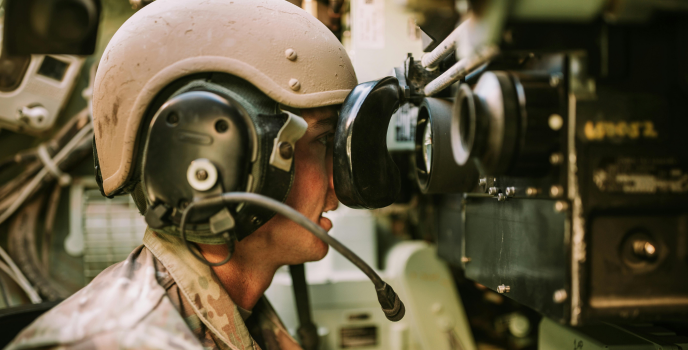China’s Victory Day military parade was its boldest, most comprehensive projection of national power, reflecting the progress of military modernization and resolve of Beijing’s strategic intent. Following the closely-watched Shanghai Cooperation Organisation (SCO) Summit in Tianjin and preceding the Fourth Plenum of the 20th Party Congress, the carefully timed and choreographed display of force to commemorate the 80th Anniversary of the Victory Against Japanese Aggression and the World Anti-Fascist War warrants a clear-eyed appraisal of China’s military prowess and the underlying challenges facing its development. The parade projected strength, but was it merely a façade masking a paper tiger?
Networked Interconnectivity: PLA Ground Forces
During the parade, the first weapons systems and platforms driven through the historic Tiananmen Square underscored the modernizing principles of networked interconnectivity shaping the PLA Ground Forces. The Type 100 main battle tank, accompanied by Type 100 support vehicle, constitute electronically integrated armoured platforms, equipped with a GL-6 active protection system and the JD-4 electro optical countermeasure system to engage a variety of guided munitions, UAVs and drones. The tank has been designed keeping in mind modern battlefield conditions witnessed during Russia-Ukraine and Israel-Palestine wars, where tanks rarely engaged each other directly. According to Chinese military affairs commentators quoted in state media, the Type 100 tank is enabled with joint communications capabilities, connecting it to assets like long-range rocket launchers and drone systems that can engage targets beyond visual range, an advancement in the direction of intellgentized interconnectivity.
Furthermore, the parade showcased China’s amphibious assault vehicle, ZBL-09, highlighting the emphasis on mobility and combined arms operations, vital for a combat scenario involving Taiwan. Following the ground forces marchpast column was perhaps the aspect of the parade most anticipated by foreign observers; the People’s Liberation Army Navy’s (PLAN) capabilities deployable in naval operations over disputed islands in the South China Sea or across the Taiwan Strait.
Technological Advancement of PLAN
The public debut of several naval drones potentially indicates the PLAN’s recognition of the success Ukrainian naval drones have had in the Black Sea, as well as a keen understanding of the combat environment in which it expects to operate. The HSU100 Uncrewed Underwater Vessel (UUV) presented at the parade is likely meant to enhance the PLAN’s reconnaissance, mining and mine-clearing capabilities in the shallow, heavily contested waters of the Taiwan Strait. The parade also showcased a slew of air defence weapons, including the HQ-9C, HQ-16C and HQ-10 missile systems, deployed by Pakistan during the conflict between India and Pakistan in May 2025, followed by the new LY-1 laser-based directed energy weapon. The presentation of “vanguard weapons” essentially comprising a layered missile defence for the PLAN is tailored towards the significant volume of missile ordnance that is likely to be exchanged in any conflict across the Taiwan Strait.
Moreover, the display of anti-ship missiles in the parade, including the YJ-17, YJ-19 and YJ-20 confirms technological advancement towards hypersonic manoeuvrability to arm the PLAN’s Type 052D and Type 055 destroyers, conventional and nuclear-powered submarines and larger warships. The previously unseen hypersonic anti-ship missiles are an expansion of the means the PLAN possesses to render American naval assets vulnerable in any future Indo-Pacific conflict.
Multi-Domain Combat Capabilities
The focus on critical, enabling capabilities was not confined to the naval segment of the parade. For the first time, the four forces- the Aerospace Force, the Cyberspace Force, the Information Support Force, and the Joint Logistics Support Force- marched as independent contingents alongside the Army, Navy, Air Force, and Rocket Force. This change illustrates the increasing importance and application of ‘information weaponisation’ and multi-domain combat capabilities, supported by the decision to showcase two Airborne Early Warning and Control System (AWACS) aircraft- the newly commissioned KJ-600 and Y-9.
The parade’s focus on multi-domain warfare reflects the PLA’s conception of success which lies in controlling the information space, communications, and paralysing an opponent’s ability to respond before hostilities have even begun. The parade then, was meant to showcase the maturation of a PLA capable of winning the ‘informationised local wars’ described in China’s 2015 Defence White Paper. Key to this objective are “new domain and new quality” capabilities like the AI-powered AJX-002 submarine drone, GJ-11 stealth attack drone, directed energy weapons and electronic jamming systems. The multi-domain capabilities reveal China’s intent to conduct complex and coordinated operations in contested environments.
Strategic Deterrence
In addition to showcasing equipment intended to demonstrate the PLA’s ability to fight a regional conflict at the operational level, the parade also sought to propagate a message of strategic deterrence. This involved the showcasing of the HQ-29 ‘satellite hunter’ interceptor missile and the JL-3 nuclear armed submarine launched ballistic missile (SLBM). With the former system capable of intercepting targets up to an estimated 500 kilometres in low Earth orbit, and the JL-3 ballistic missile assessed to be capable of delivering more than 10 nuclear-tipped Multiple Independent Re-entry Vehicles (MIRVs) out to a range of more than 10,000 kilometres, the intended message seems to be that the PLA possesses the capability to target American reconnaissance and communications satellites, intercept American ballistic missiles, and threaten all American bases in the Indo-Pacific as well as significant portions of the mainland United States.
Furthermore, the highlight of China’s missile technology display was the liquid-fuel intercontinental ballistic missile (ICBM), DF-5C, capable of carrying a 7-ton warhead, 10 nuclear bombs and striking a target 25,000 km away. The debut of the DF-61 alongside the DF-5C indicates significant enhancements to China’s second-strike capabilities as well. When combined with Xi’s remarks that ‘humanity is again faced with a choice of peace or war, dialogue or confrontation, and win-win outcomes or zero-sum games’ the intention seems to be to dissuade the U.S. from the notion of entertaining regional intervention against China in any future conflict.
Steel Dragon or Paper Tiger?
While the 3rd of September parade constituted an impressive display of Chinese military hardware, the PLA’s lack of recent combat experience amongst other factors makes it difficult to assess its overall effectiveness as a fighting force, should it be called upon to serve as such. In this regard, evidence of potentially deep-seated corruption in the PLA raises questions over its combat-readiness. Widespread graft raises the probability that certain equipment and platforms suffer from quality issues and advancements in weaponry are exaggerated or inflated for political reasons. In other cases, the effect of corruption is to sap force quality over time- the widespread practice of levelling social connections or guanxi (关系)in securing promotions and postings within the officer corps, often through buying promotions, could be expected to reduce average leadership competence and unit morale in the long term.
In a nod to the severity of the issue, Xi Jinping expanded his anti-corruption drive to include the PLA in 2014, with multiple rounds of purges since. In the most recent leadership shakeup, ongoing since late 2023, Xi has not shied away from purging senior officers personally close to him. In addition to He Weidong, Vice Chairman of the Central Military Commission (CMC), other senior personnel with close ties to Xi who have been purged include Generals Zhao Keshi, Wei Fenghe, Li Yuchao, Ding Laihang and Admiral Miao Hua. While this may indicate a genuine desire to eradicate military corruption on Xi’s part, the purges, together with his restructuring of the military (most recently in the form of the dissolution of the Strategic Support Force and the creation of the Information Support Force in its stead, and the consolidation of all four Forces under direct CMC command), have amounted to a continuous shakeup in the military hierarchy. In particular, purges of senior officers of the Southern Theatre Command, like Li Pengcheng and Liu Qingsong (former naval commanders of the PLA Southern Theatre Command) suggest disciplinary or performance limitations with the PLAN in particular, which could directly impact China’s combat readiness in the context of Taiwan or the South China Sea. Similarly, the fall of Rocket Force commanders and political commissars like Li Chuangguang, Li Yuchao, Xu Zhongbo and Liu Guanbi, have raised the question of whether key aspects of the PLA command structure, like the Rocket Forces, will decisively exercise initiative and execute orders in real time, in any future conflict.
Alongside corruption, other concerns abound, ranging from an insufficiently professionalized NCO corps which lacks the technical skills to effectively fight in the ‘informatized wars’ of the future, to challenges maintaining readiness levels owing to teething problems with the new twice-a-year conscription cycle. The possibility that the PLA’s weaknesses stem from the potential structural contradictions between its primary role of upholding the Communist Party of China’s (CPC) rule and developing into a truly ‘world class military’ means that the direction its future reforms take remains to be seen. While the Victory Day parade undoubtedly constitutes an impressive showcase of China’s military modernization on a technological level, the question of the PLA’s overall combat effectiveness will likely remain an open one for at least some time to come.



Author
Rahul Karan Reddy
Rahul Karan Reddy is Senior Research Associate at Organisation for Research on China and Asia (ORCA). He works on domestic Chinese politics and trade, producing data-driven research in the form of reports, dashboards and digital media. He is the author of ‘Islands on the Rocks’, a monograph on the Senkaku/Diaoyu island dispute between China and Japan. He is the creator of the India-China Trade dashboard, the Chinese Provincial Development Indicators dashboard and co-lead for the project ‘Episodes of India-China Exchanges: Modern Bridges and Resonant Connections’. He is co-convenor of ORCA’s annual conference, the Global Conference on New Sinology (GCNS) and co-editor of ORCA’s daily newsletter, Conversations in Chinese Media (CiCM). He was previously a Research Analyst at the Chennai Center for China Studies (C3S), working on China’s foreign policy and domestic politics. His work has been published in The Diplomat, 9 Dash Line, East Asia Forum, ISDP & Tokyo Review, among others. He is also the Director of ORCA Consultancy.
Hans Deepak
Hans Deepak is a research intern at the Organisation for Research on China and Asia (ORCA). He is a second-year undergraduate at St Catherine’s College, University of Oxford, pursuing a degree in History and Politics. His interests include international relations, military history, and strategic studies, with a particular focus on China and Southeast Asia.